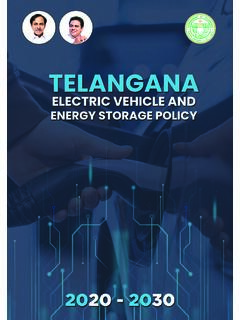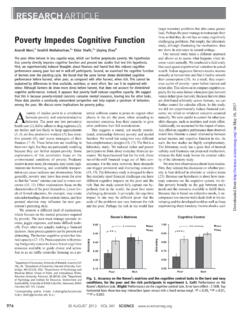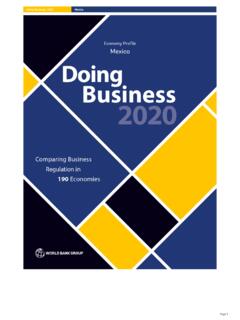Transcription of March 2021 The India Electric Vehicle Opportunity: Market ...
1 March 2021 Connected PlacesThe India Electric Vehicle opportunity : Market Entry ToolkitAuthors Lovedeep BrarBob BurgoyneLovisa ErikssonRimaljit LikhariThalia SkoufaLowri Williams Acknowledgments The authors would like to thank the following individuals and organisations for their valuable contributions to this report (errors or omissions remain the responsibility of the authors):Ms. Sonal Bhartia, Director, Investment Banking Advisory, EYShipra Bhutada, Founder, User Connect Research Agency, BenagluruDebi Prasad Dash, Executive Director, IESAM anoj M Desai, General Manager - Automotive Electronics Department, ARAIS halendra Gupta, CFO, Altigreen Propulsion LabsRaghav Handa, Director-Business Corridors, Asia Pacific, HSBC Aman Hans, Lead Consultant - National Energy Storage Mission, NITI Aayog Mark Hartmann, CTO Latent Heat SolutionsAshutosh Humnabadkar, SVP, eMobility, QuanzenSumeet Jain, Head of UK Outbound India Desk, HSBCAmit B Jain, International Director, EY-UKAnkit Kumar, CEO, GoZero MobilityHarsha Lingam, COO, Global Business Inroads Siddharth Mukne, Associate Director, UKIBCMr.
2 Gaurav Sahgal, Managing Director and Head of International Subsidiary Business, HSBC India Vivek Sharanappa, Co-founder and CEO, BuyMyEVS R Venkatesan, MD, Transvahan Technologies Professor Dr Ashish Verma, Associate Professor, Transportation Systems Engineering (TSE) and Convenor, IISc Sustainable Transportation Lab (IST Lab), Indian Institute of Science (IISc) Project partners: Enzen, Project Lithium, Shakti Foundation, Fields of View, Everything Eco, WRI, ISGF, UrbanMorph, C40 Cities, Benagluru Directorate of Urban Land Transport, Shell s E4 Accelerator ProgrammeOther organisations: SunMobility, Ather Energy, Bounce, The Energy and Resources Institute (TERI), The Confederation of Indian IndustryExecutive SummaryI. Market Overview The automotive sector in India is dominated by two-wheelers (scooters, motorbikes) and three-wheelers (autos and rickshaws) that play a significant role in last mile mobility in the country. At 22 cars per 1000 people, car ownership is low, while two-wheeler ownership is among the highest in the world.
3 While Electric vehicles (EVs) currently account for less than 1% of total Vehicle sales in India the Market is growing rapidly and expected to be worth around at least billion (INR 475 billion) by 2025. Two-wheelers account for the largest share of this Market at 62%, followed by three-wheelers at 37%. The Indian EV Market varies significantly by state, depending on factors including demographics, income levels, regulatory landscape and urbanization. The state of Uttar Pradesh, for instance, with one of the lowest urbanisation rates, has seen significant uptake of Electric two-wheelers. Maharashtra, on the other hand, with a higher urbanisation rate, has the highest penetration of Electric three-wheelers and passenger cars. The penetration of Electric two-wheelers is projected to reach up to 15% by 2025 from 1% currently. Low to medium speed Electric two-wheelers (up to 40 kmph) with lead-acid batteries currently dominate the Market but demand for Lithium-ion battery models is expected to grow rapidly under government incentives and demand from bike and scooter rental companies such as Vogo, Yulu and Bounce.
4 Many OEMs have launched high-speed (>40km/h) Electric scooters; two (Ather and Okinawa) successfully fulfilling the local manufacturing requirement under the FAME II scheme and thereby unlocking subsidies. Hero Electric , Ather Energy, Ampere, Okinawa, are establishing manufacturing units throughout the country. Three-wheelers are the dominant mode for last mile connectivity in several states including Delhi, Bihar, West Bengal and Uttar Pradesh and the Electric three-wheeler Market is expected to grow rapidly. Further growth potential lies in converting pedal rickshaws. While most Electric three wheelers are primarily low speed, growth is expected in the high-speed Market , particular for the cargo segment. The battery swapping model for supplying power has side-stepped the lack of charging infrastructure but the future is likely to see a mix of both India Electric Vehicle opportunity : Market Entry Toolkit 3 With the push from government for ICAT-certified models from late 2018, the share of larger players in the e-rickshaw segment ( Mahindra Electric , Kinetic Green and Lohia Auto) is gradually growing.
5 The four-wheeler segment currently has the lowest EV penetration of (3,400 units of Electric passenger cars sold in 2020) but may grow to 5% by 2025 in an optimistic scenario. The demand in the short to medium term will be driven by f leets including taxi and goods delivery services. For the commercial fleet segment, penetration is forecast to range between 20%-30%). Factors such as limited Market offerings, high upfront costs, insufficient battery life, high dependency on imports (with associated high tariffs), low range, power outages and crucially, an underdeveloped charging ecosystem continue to impede a higher penetration in the four-wheeler consumer segment. The Electric four-wheeler Market is currently limited to only four OEMs but several new players, domestic and international, are planning to launch their models over 2021-22. Two OEMs Hyundai and MG Motor currently import their EVs to India as CBUs or SKD (see glossary). In contrast, Tata Motors and Mahindra Electric manufacture locally.
6 EV components present a Market opportunity of another 2bn by 2025. Currently, EV manufacturing in India is being largely supported by imported components. However, large OEMs are making moves to enter the EV components Market to reduce reliance on imports and meet the 50% localisation criteria to access government Drivers and Barriers The key Market drivers and barriers with regards to increasing EV penetration and success in India are summarised in Table 1. Drivers Favourable government policies and subsidies Heavy investments from automakers Increasing diversity of products widening appeal to different groups Growing awareness of air quality and environmental issues Rising income levels in Tier-1 cities Lower Total Cost of Ownership (TCO) for EVs as compared to ICEB arriers Complex criteria and processes to benefit from government incentives (demand and supply-side) Recent decline in economic activity on account of COVID-19 Low consumer spending power outside Tier-1 cities Lack of raw material limits domestic battery manufacturing Slow roll-out of charging infrastructure High upfront costs of Electric four-wheelers compared to ICE vehicles Electricity network reliability issues Table 1 India EV Market : Drivers and Barriers4 Executive SummaryII.
7 Opportunities and Understanding the ConsumerThe EV transition in India opens up a range of opportunities for UK companies across services, vehicles, battery supply chain, charging infrastructure, and the electricity system. In general, these opportunities would be best pursued through a joint venture or other partnership with a local entity. Selected opportunities include:Services and Solutions First and last mile micro-mobility and shared mobility EV services have potential (particularly for female travellers) offering opportunities for software providers for route-optimisation tools. Solutions to managing charging and range anxiety: Analytics solutions to understand current range left given weather and traffic conditions. Journey planning tools which incorporate planning for battery re-charging or Vehicles Cutting edge design and innovation in various elements of components manufacturing including electrical steel, cells, batteries and battery management systems.
8 Fleet optimisation software and services for ride-sharing, employee transport and last-mile freight companies. Vehicle sales, particularly premium offerings targeting the top end of the Infrastructure Mass Market adoption of EVs requires a charging infrastructure that is affordable, accessible and serves all consumer groups. Partnering with Indian Vehicle OEMs to provide charge point hardware and software could be a route to Market for UK charge point manufacturers. Specific opportunities include affordable and reliable public charging infrastructure, with appropriate considerations for the Indian Market ( two/three-wheeler compatible); battery swapping technologies, and online platforms for charging infrastructure SystemSupplying green electricity for EV charging and taking advantage of the f lexibility offered by EVs are longer term targets for India . Although the electricity Market would need change to enable f lexibility solutions, there are some areas where innovation is needed today, and UK companies The India Electric Vehicle opportunity : Market Entry Toolkit 5can potentially find opportunities in the following areas: Solutions to deliver consumer propositions that successfully access f lexibilityi, in particular related to EV charging.
9 Tools that provide a richer understanding of how transport, power, energy and town planning interlink and can be coordinated. Systems that improve the understanding and visibility of current and future states of the Indian energy system. Automatically controlled interventions; storage, compensation and filtering. Technologies to decouple the grid from charging Indian EV consumer The Indian (mass) Market is very price sensitive. Working to incorporate local components in order to access subsidies can help - as well as highlighting potentially cheaper total ownership costs. EVs are generally well suited to Indian driving conditions; points to emphasise for product launch. However, ensuring that safety and performance is delivered in the context of a variable climate, poor roads and a start-stop driving style is important. Test-drives can help provide reassurance. Prospective consumer customers have concerns about battery life and charging availability which are often not material given the likely usage profile in India .
10 Nonetheless, software for route planning and information on charge point locations may alleviate concerns. Usage is heavier amongst professional drivers; battery swapping provides an interim solution and there will be a ready Market for fast-charging solutions when they become price competitive. Consumer customers worry about accessing servicing and maintenance support for their EVs: consider bundling these with the Vehicle purchase. Vehicle ownership is an importance badge of status in India with larger private vehicles being prized. To encourage adoption of Electric micro-mobility solutions or 2-wheelers, help owners signal their eco-credentials, something which is also socially desirable. The user experience of EVs depends on the ecosystem as a whole important to engage and build partnerships therefore to help prevent a poor experience which isn t within direct Flexibility is defined as modifying generation and/or consumption patterns in reaction to an external signal (such as a change in price) to provide a service within the energy system.






